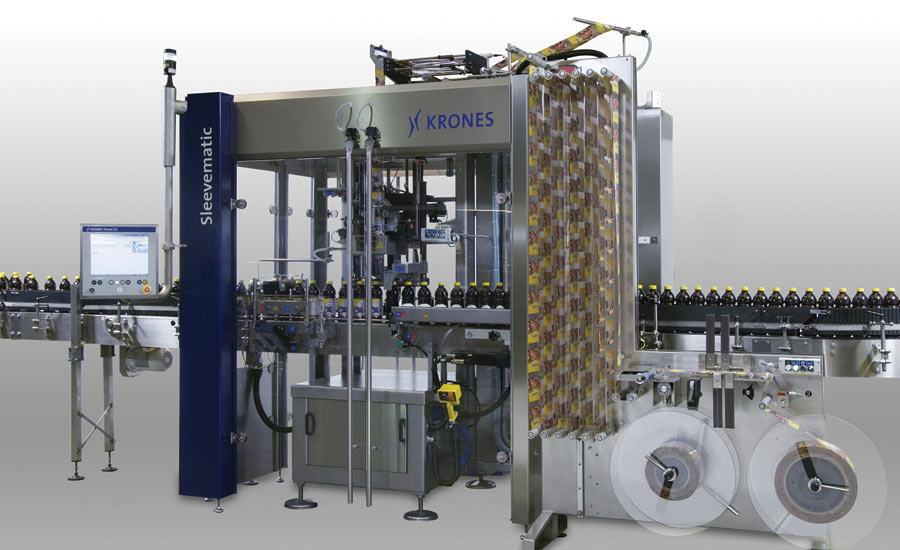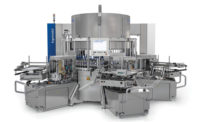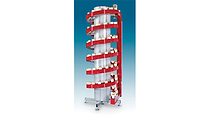Modular labeling systems aid beverage-makers
SKU proliferation, changeovers require flexible labeling equipment

Children’s toys like Connectagons bill themselves as offering limitless opportunities for constructing various objects. Although labeling equipment cannot be adapted as easily as these skill-building toys, original equipment manufacturers (OEMs) are developing systems that are more modular to support the evolving beverage market.
Among the trends prompting the need for flexible machinery is SKU proliferation. Justin Slarks, director of marketing for Little Rock, Ark.-based Sleeve Seal, notes that SKU proliferation has both positive and negative arguments.
“The SKU proliferation phenomenon is a reality, like it or not,” he says. “In the case of co-packers, all of our customers are changing formats to meet their customers’ needs. Or, in the case of dedicated production, the container format changes very little, but they may be changing labels to accommodate updated flavors, ingredients or artwork.
“Sleeve Seal has engineered our machines to make change parts both affordable and easy to change with manual, tool-less adjusters and press-of-a-button format ‘recipes’ on the [human machine interface] (HMI),” Slarks continues. “Changeovers may or may not happen daily, but our machines are ready for accurate, repeatable performance over a broad range of formats.”
Dave Niemuth, technical sales manager of labeling for Krones USA, Franklin, Wis., also highlights the growing impact that changeover is having on operations. “Changeover times are becoming more and more important, significantly influencing the overall efficiency of equipment,” he says. “A modern labeler must reduce handling parts as much as possible and, if needed, quick change parts must be created. In addition, the labeler must run the rated speeds after the changeover.”
To support this trend, Krones offers its Modular Labeler. “This machine is not linked to one particular labeling system but can be used with different labelling variations such as paper with cold glue, paper with hot melt, pressure sensitive, or wrap-around film with hot melt,” he explains. “The labeling stations are changeable, with one module easily taking the place of another module on the base machine. The Modular Labeler can also be retrofitted with multiple stations to increase speeds.
“Our customers clearly see the need of such flexibility in a machine especially when they need to apply multiple labels on one product, i.e., paper and pressure sensitive,” Niemuth continues. “In addition, the labeler supplier is no longer responsible just for applying a label. Drying, orientating, labeling, coding, inspecting and data management are all part of the requirements. A good supplier is offering the entire system and takes the full responsibility of recommending the correct equipment.”
Sleeve Seal’s Slarks also highlights how the company recognizes the needs for modular systems to support the beverage market. “Sleeve Seal offers modular systems with easy to change, cost-effective change parts that allow plants to switch formats several times a day, if needed,” he says. “We are engineering with the future in mind and are always evaluating our existing equipment.”
A thin line
The proliferation of new beverages also has resulted in a growing number of packaging options. As beverage manufacturers are addressing sustainability and cost issues, primary packaging structures have transformed, thereby placing new demands on labeling equipment.
“Our view is that customers are driving the move to recyclable materials and manufacturers are moving to thinner films now that machines are available to apply the thinner materials at speed,” Slarks says. “Recyclable bottles and film are a little more expensive, but the brands can market this to customers who feel good about the containers and labels. Thinner film is really the exciting change in the industry. Sleeve Seal is producing machines capable of applying labels at 25 micron and brands are realizing that the cost of materials, shipping and changeover times are all decreased. With these savings, they can easily offset the cost of recyclable materials.”
Krones’ Niemuth also highlights that thinner labels have helped to reduce costs and natural resource usage, but also points to other ways in which sustainability has impacted labeling equipment.
“The design of the machines has changed over the last years,” he says. “Saving energy by using efficient drives and reducing pressurized air (very costly) is a must.”
Although lightweighting and sustainability trends have influenced the labeling equipment market, experts note that many other factors are influencing the next generation of machinery.
Among them are higher machine speeds and specialty/unique designs and bottles to highlight brands, Niemuth says.
Sleeve Seal’s Slarks also notes the influence that packaging design is having on machinery. “The level of visual impact has changed in the last few years, [so] designers have a new canvas to work with,” he says. “Better quality, lower-priced printing and higher-quality substrates are allowing designers to realize their design visions and create unique, high-end looking labels. Some of the label designs we are seeing are amazing — metallic, matte varnishes, varieties of spot colors — the combinations are endless.”
Diverse needs
The number of new brands and companies has contributed to the SKU proliferation within the beverage market. With large beverage companies expanding their portfolios, whether through mergers and acquisitions or new product development, and entrepreneurial beverage companies emerging, the needs for each manufacturer can vary greatly.
Because of these variances, labeling equipment manufacturers are ensuring that they can be solution providers to both.
“The big players want affordable, reliable equipment that can perform all week long with no down time and very high efficiencies,” Slarks says. “More and more we are incorporating ‘smart’ controls that take operator errors out of the equation and also allow us to make changes and apply diagnostics remotely. The idea that our techs can review performance and make changes the same day is very appealing to large-scale operations.”
Slarks adds that smaller/craft beverage operations have experienced increased competition because of explosive growth, but have encountered challenges when looking to scale up.
“Growing production is challenging. I think that the craft-level brands are looking for affordable, reliable equipment that can handle label changeovers easily,” he says. “We have addressed this with our new FS1 labeler, which is a scalable machine that can expand as production increases.”
Krones’ Niemuth also notes the different needs states regarding labeling equipment for large and small operations, with large companies wanting the “highest flexibility combined with highest efficiency, shortest changeover time, reliability, worldwide service and an excellent lifecycle service network.”
However, he adds that for the emerging brands, the needs can vary from company to company. “For example, winery customers need a cost-effective solution which can handle a complex operation, all the while utilizing less space. For this application, a bloc version is often the right answer,” Niemuth says. “However, for a craft beer brewery, often the high number of SKUs is the challenge and a can production line with a sleever might be the right choice. As you can see, there is not only one answer. Every customer has their own special requirements.”
Because of this diversification, Krones offers a large portfolio of label application machines. “For small batches, it can be more cost-efficient using hot melt cut-and-stack; for higher volume, the reel-fed technology is the right choice,” he explains. “For beer decoration, a paper label is the best in terms of efficiency; but if the marketing department decides the product needs a ‘no label’ look, pressure sensitive must be used. For the right decisions the portfolio needs to be complete to enable the right choice for customer demand.”
Sleeve Seal’s Slarks also highlights the company’s variety of labeling equipment options. “Our entire line of vertical sleeve labelers are used extensively in the beverage industry,” he says. “We also manufacture shrink tunnel systems and label accumulation systems — everything is modular so custom systems can be pieced together with ease.
“All of our machines feature a similarly rugged drivetrain and chassis with options for speeds and container dimensions,” Slarks continues. “Speeds range from 100 to 1600 [cans per minute] (CPM)/[bottles per minute] (BPM), sizes range from lip balm-size to oversized protein powder tubs. Accuracy, repeatability and durability are all important factors for our line of labelers.”
Jim Lambert, vice president and general manager at INX International Ink Co., Schaumburg, Ill., notes that large operations typically will have requests that might compete with traditional printing methods. “High-end brands often are very critical of digital color,” he says. “They wish to preserve their brand’s color as they transition from the spot to process color arena. On the other hand, small beverage operations tend to request lower entry costs, while having lower requirements. Understanding these requests and requirements will be crucial to creating a reliable solutions for these customers.”
Future planning
As demands placed upon labeling equipment grow, OEMs recognize the technology advancements that have gotten them where they now are and are preparing for what could be next.
“It is in every company’s interest to use the newest technology when it’s offering benefits for your customer,” Krones’ Niemuth says. “Servo drives are used more and more to obtain additional flexibility and energy efficiency. In the future, we will have new challenges such as personalization. Digital systems will have a much bigger impact.”
Sleeve Seals’ Slarks anticipates the key provisions going forward will be user-friendly accommodations.
“As we approach the limits of shrink films and application equipment, we are entering the age of smarter, more operator-friendly equipment,” he says. “Sleeve Seal offers on-board knowledge bases that include operations manuals and video tutorials. Our controls team is always exploring new technologies to assist the operator in consistent, high-efficiency production runs and continue to develop remote access programming and diagnostics.”
Because of these limits, Slarks expects more enhancements or add-ons could be in store when it comes to design and printing of labels. “We have the ability to create wild looking labels now — glow-in-the-dark, scratch off, metallic, matte varnishes, pearlescent varnish, etc. — and are starting to see textural inks that physically ‘feel’ different. Designers are putting together some amazing combinations.”
Although new label material qualities will be able to offer much in the future, Krones Niemuth says that costs considerations will remain a key deciding factor. “The market is driven from cost optimization, but not only for the labeling machine,” he explains. “Total cost of ownership is a value, which is becoming more important. Pressure-sensitive labels will grow in the beverage market, and sleeving will grow at an above average pace. However, these two relatively expensive label applications have a very high customer approval rating.” BI
Looking for a reprint of this article?
From high-res PDFs to custom plaques, order your copy today!






